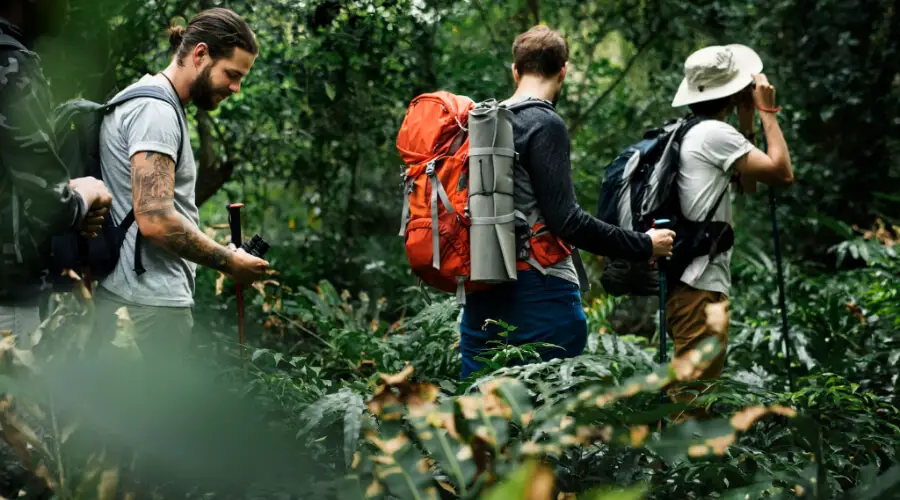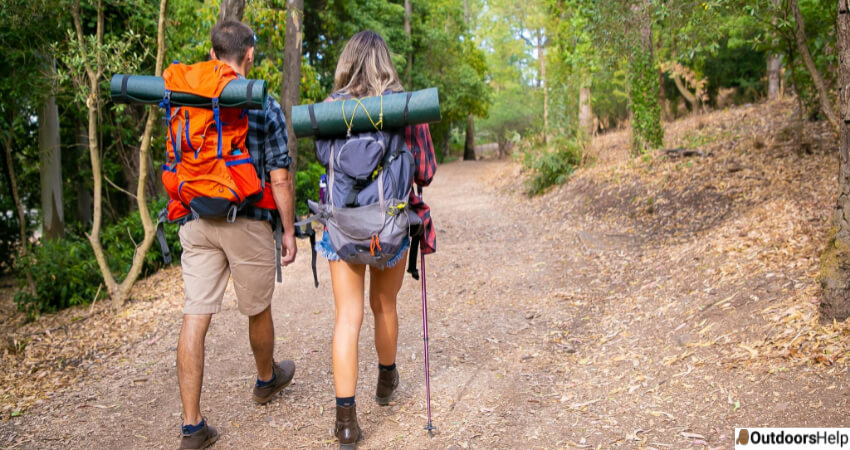Trekking and hiking are often incorrectly used to mean the same thing. Most people think that the words are synonyms of each other. If you are an outdoor enthusiast, keep reading this page, and you will better understand the two terminologies.
Are Trekking And Hiking The Same Thing?

No, though outdoor enthusiasts interchangeably use the two words to refer to the same activity, they are two different outdoor activities almost similar. The two activities involve taking a walk to connect with nature. The Oxford Dictionary defines trekking as a long, difficult journey on foot, while hiking is defined as an activity of taking long walks in the country for pleasure.
However, while hiking has marked trails to be followed, trekking has no trails; thus, you can walk across the trails into dirt paths and the wilderness without following a particular path.
The Differences Between Trekking And Hiking
when you compare the two definitions, not much difference exists between the two activities. They both involve long walks, but trekking is defined as a difficult journey. Please note that trekking is more than a mere walk; hence it is defined as a journey while hiking is a walk.
A Comparison Table Between Hiking And Trekking
| Hiking | Trekking |
| Hiking is purposely done for pleasure to connect with nature and relax the mind. | Trekking is also done for pleasure, but a particular destination is predetermined. In most cases, it involves a search for moral impact. |
| Hiking is done on known hiking trails and paths. | Trekking is done across the country, on mountain trails, or in complete wilderness. |
| Hiking can be accomplished overnight, and it involves 4km to 50km | Trekking lasts for many days, and it involves between 50km to 24,000km |
| Hiking might be a short day activity or an overnight adventure | Hiking takes a minimum of two days or the longest you can take to reach the predetermined destination |
| Walking for 5 hours is sufficient for hiking. | Trekking puts you to the test mentally and physically. Accomplishing the task challenges you physically and demands that you be in a healthy physical condition. It would help if you were prepared to walk 7 hours a day. |
| Hiking requires light packing since you are not going to spend forever on the adventure. | Packing for trekking is tasking. It would be best if you had assortments such as sleeping bags, cookware, food, clothes, sufficient water, strong boots, a medical kit, and many more. |
Here below are notable differences between trekking and hiking;
1. Duration
The major difference between these two outdoor activities is the time taken to accomplish them. Trekking takes a minimum of two days, but in most cases, it takes more days. The maximum hours a trekking person can walk per day is 7 hours. People who engage in trekking have a predetermined destination in mind, and they work hard to reach there. Their determined walk can cover thousands of kilometers per single trekking adventure.
On the other hand, hiking activities are shorter. People who go hiking take a few hours walk or sometimes the entire day. In some instances, hiking can also involve a night experience, but it doesn’t take several days, as is the case with trekking.
2. Terrain
The terrain that the two activities take place presents another difference between trekking and hiking. Hiking is commonly done on marked trails. The trails go through forests, hills, mountains, and other natural scenes people intend to explore. Comparatively, trekking escapades are not necessarily done on marked trails. The journey can take you through unexplored nature that comprises varying terrains. The trekking terrains include beaches, mountains, forests, roads, and even the wilderness. Trekkers boast of exploring virgin nature scenes, thanks to their freedom of not following a particular trail. People who hike are generally not confined to a marked walking path, as is hiking.
3. Accommodation
Hiking can also be an overnight activity. In such a scenario, hikers set a sleeping base in one place. For instance, hikers may choose to spend the night in a certain hut where they will return every other night.
Trekkers don’t have a particular base where they can return to after the day’s escapades. Their journey targets a specified destination; hence they never return to the same location to spend a night.
Accommodation for trekkers depends solely on the trekking route and, to an extent, the weather condition. Places of accommodation for trekkers are; lodges, hotels, or mountain tents.
4. Equipment
The equipment used in the two nature exploring activities is not the same. Hikers need basic equipment such as boots suitable for the chosen terrain, a backpack containing food, water, and a few necessities. Maps and compasses are unnecessary since the hiking route is marked for you. Hiking trails have signs that notify you where you are, the route you will take, and the distance to where you are heading.
Trekkers don’t have the luxury of marked trails; hence they require more equipment to accomplish their journey. When you embark on trekking, you must have maps and compasses to guide you towards your desired destination. Other pieces of equipment that are a must-have for trekkers are; sleeping mats, sleeping bags, multipurpose breathable clothes that are fast-drying, sleeping bags, first aid kits, medicines in case of underlying issues, and several other necessary types of equipment.
5. Exertion
Trekking is a demanding activity that is not for every Harry, Tom, and Dick. To trek for several days successfully without stopping requires adequate preparation and training. You should be prepared for the daring journey both physically and mentally.
Unlike trekking, hiking is a leisure activity in which almost everyone can partake. There are several hiking trails, so you can choose the one that conforms to your physical abilities. If you are not on a top-notch physical level, you can settle for an easy hiking level that you will manage. However, difficulty hiking levels call for preparedness, but not as intensive as trekking.
Conclusion
There you have it. Although both hiking and trekking aim to explore nature and relax the mind, there are a few differences, as discussed above. Grasp the differences and determine whether you are going for a hike or a trekking journey.

